The 2022 Milliman Long Term Care Insurance Survey, published in the July issue of Broker World magazine, was the 24th consecutive annual review of long-term care insurance (LTCI) published by Broker World magazine. It analyzed product sales, reported sales distributions, and detailed insurer and product characteristics.
From 2006-2009, Broker World magazine published separate group LTCI surveys, but discontinued those surveys when the availability of group LTCI policies shrank. In 2011, Broker World magazine began this August annual analysis of worksite (“WS”) sales to complement the July overall market analysis.
The WS market consists of individual policies and group certificates (“policies” comprises both henceforth) sold with employer support, such as permitting on-site solicitation and/or payroll deduction. If a business owner buys a policy for herself and pays for it through her business, participants likely would not report her policy as a WS policy because it was not part of a WS group. If an employer sponsors general LTC/LTCI educational meetings, with employees pursuing any interest in LTCI off-site, sales would not be reported as WS sales.
We limit our analysis to US sales and exclude “combination” products, except where specifically indicated. (Combination products pay meaningful life insurance, annuity, or disability income benefits in addition to LTCI.)
About the Survey
Our survey includes WS sales and statistical distributions from National Guardian Life, New York Life, and Northwestern, and WS sales data from LifeSecure. We estimated sales from four other stand-alone LTCI insurers and compare WS sales to individual LTCI policies that are not WS policies (NWS) and to total sales (Total).
Highlights from This Year’s Survey
- As we reported in our July 2022 article, results are heavily influenced by the state of Washington’s “Washington Cares Fund” (WCF, see the “Market Perspective” section for more info). To study the impact of the WCF, we surveyed combination product life insurers in addition to our typical survey of stand-alone LTCI companies. Approximately 60 percent of sales in each line occurred in Washington (“WA”). The industry sold more than 90 times as many stand-alone LTCI policies sales in WA in 2021 than in 2020 and, based on a significant sampling of combination (life and LTCI) policies, that product line also experienced in WA more than 90 times as many sales in 2021 than in 2020.
- Driven by WCF’s exemption for private LTCI coverage, we estimate about 9.3 times as many stand-alone WS sales in 2021 (approximately 90,000 in 2021) compared to 2020, while NWS sales increased 47 percent. However, we estimate that new annualized premium grew at a slower pace compared to policy counts—WS premium tripled in 2021 (approximately $60 million in 2021), while NWS premium increased by six percent. The smaller growth in premium arises because the 2021 sales had a higher mix of younger age individuals and a higher mix of less-expensive policies, which was driven by WA sales where individuals sought lower cost policies that would earn exemption from WCF. Our data does not allow us to estimate how much stand-alone LTCI WS sales increased in WA.
- Our WS stand-alone statistical distributions can vary significantly from year-to-year because insurers focusing on particular WS markets may be over- or under-represented. We estimate that our statistical distributions reflect only about five percent of WS policies. The carriers providing 2021 statistical data had an average WS annual premium of $2,077 (less than half as much as last year, due to WA sales), whereas the others had an estimated average WS premium of $600, which indicates that our statistical analysis continues to be overly weighted toward executive carve-out programs.
- Ten insurers contributed combination sales data: AFLAC, John Hancock, Mass Mutual, New York Life, Nationwide, Northwestern Mutual, OneAmerica, PacLife, Securian, and Trustmark. 64.9 percent of their national combined 300,000 sales and 13.4 percent of their national $1.1 billion of new annualized premium were WS sales. Of national WS combined Life/LTCI sales, 73 percent of both the new policies and new premium were in WA. Within WA, 79 percent of new policies and 50 percent of new premium came from WS sales.
- Although we have a significant sample, full industry life/LTCI combination sales may differ significantly if our data is over-weighted (or under-weighted) toward WS business, as the WS market grew in WA much more than the NWS market did.
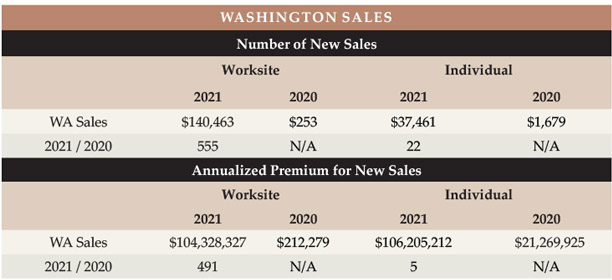
MARKET PERSPECTIVE
The three segments of the WS market (which may apply to different employee classes in a single case):
- In “core” (also known as “core/buy-up”) programs, employers pay for a small amount of coverage for generally a large number of employees. Employees can buy more coverage. “Core” programs generally have low average ages, short benefit periods, low daily maximum benefits and a small percentage of spouses insured.
- In “carve-out” programs, employers pay for robust coverage for key executives and usually their spouses. Generally, executives can buy more coverage for themselves or spouses. Compared to “core” programs, a higher percentage of insureds are married, more spouses buy coverage, the age distribution is older and average premium is higher.
- In “voluntary” programs, employers pay none of the cost. The typical coverage is more robust than “core” programs, but less robust than “carve-out” programs. Voluntary programs tend to be most weighted toward female purchasers.
National Guardian, New York Life, and Northwestern write mostly executive carve-out programs and are the only insurers that contributed to our statistical distributions; therefore, our data is heavily-weighted to the executive carve-out market.
Because of tax savings, small executive carve-out issue dates are weighted toward the end of the year. On the other hand, large voluntary cases are traditionally weighted toward fall enrollments with January 1 effective dates. Large voluntary cases are probably more evenly distributed through the year than in the past, but differences remain.
Carrier and product shift: The future of the non-executive carve-out LTCI market is unpredictable with Transamerica’s departure. Even if LifeSecure, Mutual of Omaha, and National Guardian pick up market share, WS stand-alone LTCI sales might drop, at least temporarily because it takes time for competitors to fill in after an insurer drops out.
Particularly for young and less-affluent groups, voluntary programs may gravitate toward products that include life insurance, which is viewed as a more immediate potential need by young employees with families. The possibility of guaranteed issue also draws employee benefit advisors and employers to such products. Such products can allow 100 to 300 percent of the death benefit to be used for LTC, at a typical rate of four percent of the death benefit per month. Unfortunately, combination WS products’ LTCI benefits can lose substantial purchasing power by retirement years because the benefit typically does not increase.
WCF: WA state’s “Washington Cares Fund” imposes a 0.58 percent employee-paid payroll tax to fund a $36,500 lifetime pool (intended to inflate according to the WA consumer price index) for care received in WA as defined in the Revised Code of WA 50B.04. However, people who purchased qualifying private stand-alone or combination LTCI by November 1, 2021 could file to be exempt from the tax. (Note: WCF had received 478,173 applications for exemption as of June 13, 2022.1)
Other jurisdictions may create state-run LTCI programs, but they may not create a window for people to become exempt by buying insurance after the law has passed.
COVID: COVID-19 (COVID) continues to impact the employee benefit market in many ways. As LTCI is generally not perceived to be an urgently-needed benefit, LTCI may be more impacted than some other benefits. Employers potentially have various existential issues that may take precedence over offering LTCI. Staff turn-over is generally higher and more positions are vacant. Shifting of the workforce to remote can be harder to enroll, all else equal.
Nonetheless, COVID did not appear to deter the WA WS sales and, as a result of COVID, there is increased awareness of the LTC risk and of personal exposure and increased interest in staying out of nursing homes. More workers may have elders living in their homes and, if they are remote workers, the needs of those elders are more likely to interfere with their productivity.
Pricing and Underwriting Considerations: Most people interpret Title VII of the 1964 Civil Rights Act to require that employer-involved LTCI programs use unisex pricing if the employer has had at least 15 employees for at least 20 weeks either in the current or previous year. Some states apply similar laws to employers with fewer employees. Thus, for WS sales, insurers must create a separate unisex-priced product. The expense of separate pricing, marketing and administration discourages insurers from serving both the WS and NWS markets.
Moreover, insurers fear anti-selection. Because women have higher expected future claims, unisex pricing saves women money compared to gender-distinct NWS pricing, whereas men pay much more for WS than for NWS policies. The higher the percentage of female buyers in the WS, the more unisex pricing is likely to approach gender-distinct female pricing levels.
Insurers also fear health anti-selection (less-healthy people buying, while healthier people do not buy). Insurers are more vulnerable to health- or gender-anti-selection if the group has a large portion of young or less affluent employees as this group is generally less likely to buy LTCI.
Furthermore, because WS programs rarely offer “preferred health” discounts, healthy couples may pay more for WS coverage than for corresponding NWS coverage. Although there are few health concessions in the stand-alone WS market at this time, some combination products offer guaranteed issue if participation requirements are satisfied.
To control risk, most insurers will not accept a voluntary WS program if there are fewer than 100 employees. However, one insurer (which offers no health concessions) will accept voluntary LTCI programs with as few as 2 to 5 (varies by jurisdiction) employees buying.
In the carve-out market, a more expensive WS product can still produce after-tax savings compared to a cheaper NWS policy, because of tax advantages when an employer pays the premium. The specter of future tax increases enhances the attractiveness of employer-paid premium.
Availability of coverage: Some insurers have raised their minimum issue age to avoid anti-selection (few people buy below age 40) and to reduce exposure to extremely long claims. Such age restrictions can discourage employers from introducing a program, especially a carve-out program if they have executives or spouses under age 40.
With increased remote work, more employers have employees stretched across multiple jurisdictions and eligible non-household relatives might live anywhere. But insurers are less likely than in the past to offer LTCI in jurisdictions with difficult laws, regulations or practices. So, it can be difficult to find an insurer which can cover everyone unless LTCI is sold on a group policy form and the employer does not have individuals in extra-territorial states.
One insurer no longer offers WS LTCI to non-household relatives. Reduced availability for such relatives does not have much impact on sales, because only about one percent of WS sales are to non-household relatives. However, it undermines the suggestion that WS LTCI programs might reduce the negative impact of employees being caregivers.
Prior to gender-distinct pricing, an executive carve-out for two partners of a company with more than 15 employees could have been serviced by any LTCI company, but now it is hard to find a carrier that offers unisex pricing under such circumstances. Such executives may buy policies with gender-distinct pricing either because they are unaware of the requirement under Title VII of 1964 Civil Rights Act; they may disagree with the interpretation that such policies should have unisex pricing to avoid the risk of a civil rights complaint, etc.
Some employee benefit brokers are reluctant to embrace LTCI because of declinations, the effort of enrollment, certification requirements, their personal lack of expertise, etc. WS sales gain from LTCI specialists forming relationships with employee benefit brokers.
Support for Employees who are Caregivers: Various programs offer LTC-related services to employees and their families. Regardless of whether the employee is insured or the relative is insurable, they may be able to access information, advice, services, and products that make caregiving more efficient, more effective, safer, and less expensive. Enabling employees and their families to have better LTC experiences and to use more (not necessarily 100 percent) commercial care should boost productivity at work. Some of these programs are packaged with WS LTCI.
STATISTICAL ANALYSIS
As mentioned earlier, insurers’ sales distributions can vary greatly based on the submarket they serve (for example, in the WS market: core, voluntary, or carve-out). Therefore, in addition to fundamental changes in the industry, distributions may vary significantly from year to year due to a change in participating insurers, distribution within an insurer, and market share among insurers. Policies in the carve-out market are designed similarly to those in the NWS market. Our sales distributions reflect only stand-alone LTCI and only about five percent of stand-alone WS policies issued in 2021, unless otherwise noted. The distributions mostly represent the executive carve-out market, as these insurers averaged 10.6 issues per case.
Sales and Market Share
Table 1 shows historical WS sales, including some estimates. It shows overall average WS premium for all carriers which reported sales compared to the average WS premium for the participants who contributed statistical data beyond sales. As shown in the table, until 2017, our WS statistics likely represented the broad WS market reasonably. Average premiums plummeted this year because of the WA sales.
Table 2 shows WS sales as a percentage of total LTCI sales, both including estimates. WA sales caused WS sales to be larger percentage of the total compared to past survey data.
Table 3 and the following tables do not include estimates. Thus, Transamerica, which was the #1 insurer in 2020 and 2021, is not included. LifeSecure leapfrogged to the top.
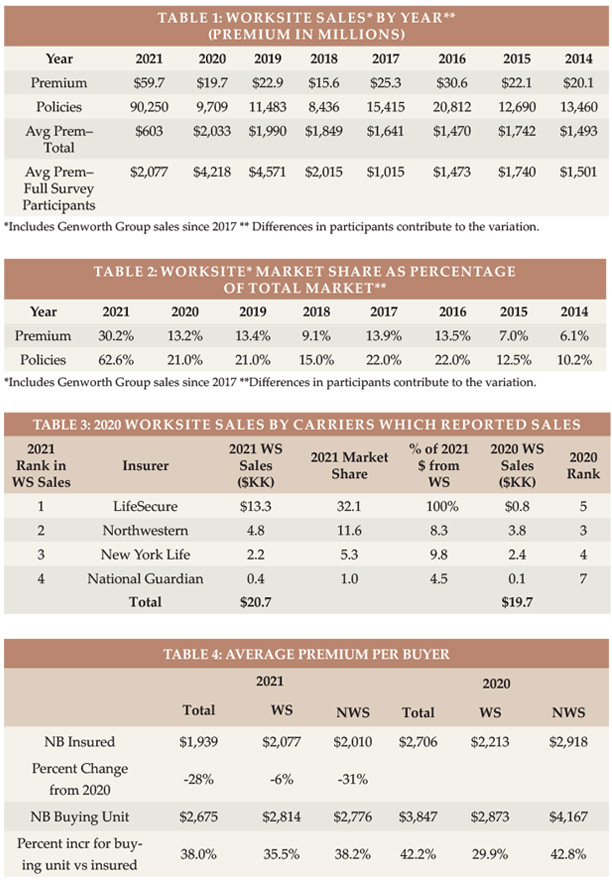
Average Premium Per Buyer
Table 4 shows that, in 2021, the average premium per insured in the WS market dropped twice as much from 2020 levels than did the average premium in the NWS market.
As always, the average premium per buying unit (a couple comprise a single buying unit) is higher because there are fewer buying units than insureds. Normally, the increase in average premium per buying unit compared to per insured is significantly lower for WS sales, because more WS buyers are single and because spouses are less likely to buy in the WS. Those factors are muted materially because our data is weighted toward the carveout market. In 2021, the reported differences are small, perhaps influenced by the WA sales.
The average premium per new insured (NB Insured) reflects all participants, but the average premium per buying unit is determined solely by the participants who report sales based on marital status. The WS ratio is probably overstated because participants who reported premium by marital status for the WS are not characteristic of the entire market.
Issue Age
In reviewing the balance of the statistical presentations, we urge you to be selective in how you use the data because it is not representative of the entire WS market as explained above.
Table 5 shows that WA sales dropped the average age in the NWS market by 7 years, but only by 3 years in the WS market. If our data included more of the WS market, our WS average age might have dipped more.
Table 7 displays the relative age distribution of workers ages 16+ vs. the age distribution of purchasers in the WS market. It also shows the age distribution of adults 20-79 compared to the age distribution of purchasers in the NWS market. If the percentage of sales in a particular age group is higher than the percentage of population in that age group, the LTCI industry penetrates that age group well. As was the case last year, when we instituted this table, the industry is particularly effective with ages 30-49 in the WS market. In the NWS market, the industry was particularly effective for ages 50-69 last year, but this year broadened the effective range down to 30 because of WA sales.
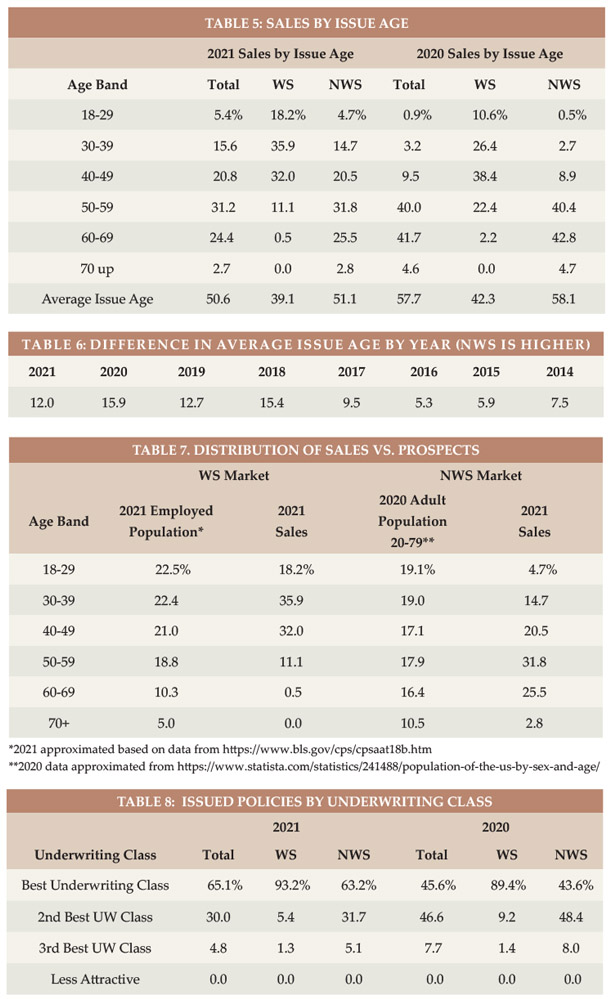
Rating Classification
Most WS sales are in the “best” underwriting class (see Table 8) because there generally is only one underwriting class. Insurers often do not get enough information in WS to determine whether a “preferred health” discount could be granted and use the additional revenue (from not having a “preferred health” discount) to fund extra cost resulting from gender or health anti-selection. Carve-out programs are more likely to offer a “preferred” discount, which means a higher percentage of carve-out policies are issued in the second-best underwriting class. The percentage of policies issued in the best underwriting class soared in the NWS market in 2021 because younger and healthier buyers were drawn to LTCI in WA. The impact on the WS market was smaller, because so few people did not qualify in the best category in 2020. In each market, about 35 percent of buyers who did not qualify for the best price in 2020 shifted into the best category in 2022.
Benefit Period
The WS average benefit period is low for core/buy-up programs and somewhat low for voluntary programs. Executive carve-out programs sometimes have longer benefit periods than the NWS market. In 2021, the average benefit period in each market dropped by about a half-year due to WA sales.
The difference in benefit periods between the markets is actually larger than these statistics indicate, because these statistics ignore Shared Care (and the WS market issues much less Shared Care).
Table 10 shows corresponding data back to 2014. As noted elsewhere, this data can jump around based on which insurers provide such detail and whether large core/buy-up cases are written in a particular year.
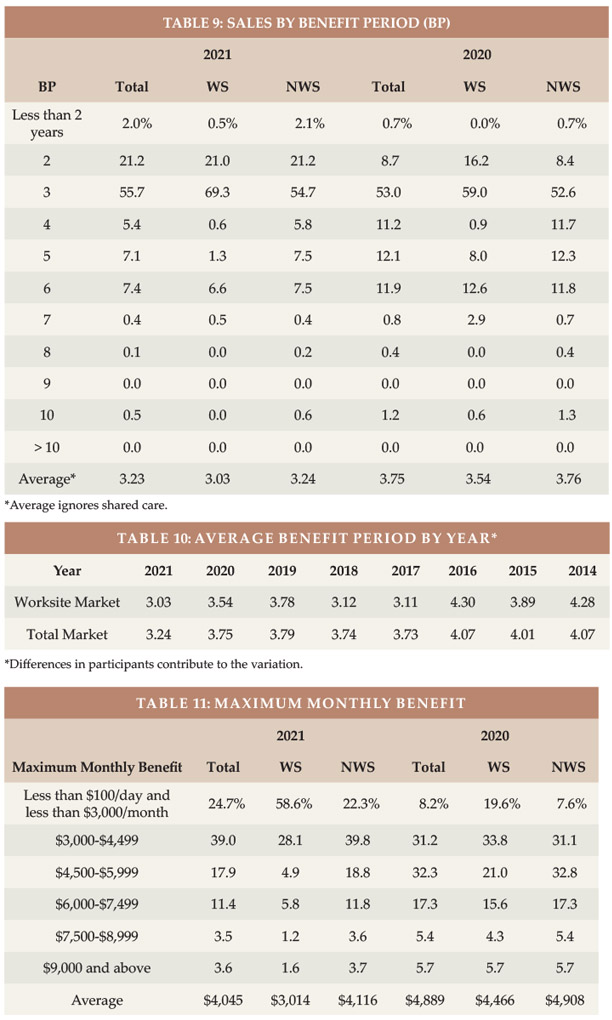
Maximum Monthly Benefit
In 2020, the average initial monthly maximum was about nine percent lower in the WS market than in the NWS market. In 2021, the difference tripled to 27 percent lower in the WS market. To calculate the average initial monthly maximum, we presume an average size in each size range. The $2,100/month we assume for the smallest size range seems to overstate dramatically in 2021 as many people opted for the minimum $1,500/month.
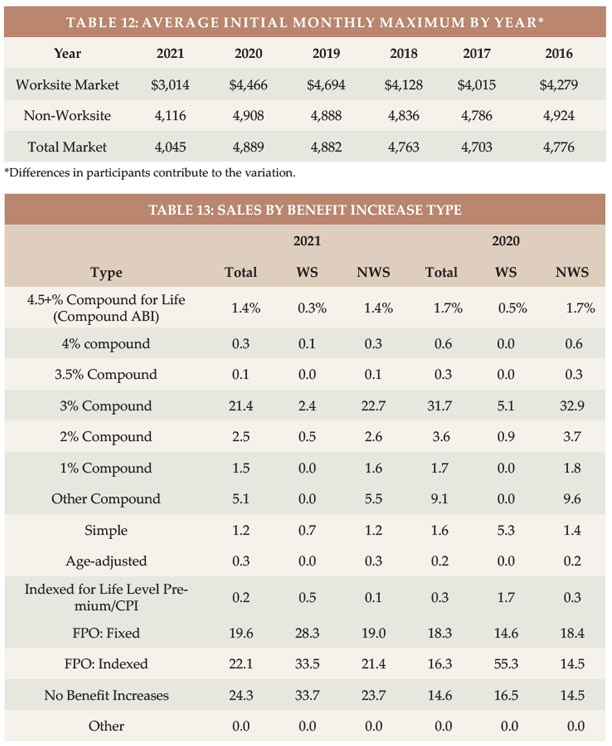
Table 12 shows that the WS initial monthly maximum has varied more over time than the whole market, because of participant changes and how many core/buy-up plans were sold in a particular year.
Benefit Increase Features
As shown in Table 13, 95.5 percent of 2021 WS sales had no benefit increase feature or a future purchase option (FPO), hence no first-year premium for benefit increases. The corresponding NWS percentage was 64.1 percent. The corresponding 2020 sales percentages were 86.4 percent and 47.5 percent.
Future Protection
Based on a $27/hour cost for non-professional personal care at home ($27 is the median cost according to Genworth’s 2021 Cost of Care Survey), the average WS initial maximum daily benefit of $100 would cover 3.7 hours of such care per day at issue, whereas the typical NWS initial daily maximum of $137 would cover 5.1 hours of such care per day, as shown in Table 14. This year’s higher cost (the hourly cost was $24 in 2020) and lower initial monthly maximums contributed to the 40 percent decrease in WS hours (from 6.2 WS hours) and 25 percent decrease in NWS hours (from 6.8 NWS hours) from last year.
The number of future home care hours that could be covered depends upon when care is needed (we have assumed age 80), the home care cost inflation rate between now (age 39 for WS and 51 for NWS) and age 80 (we have calculated with two, three, four, five and six percent inflation), and the benefit increases provided by the LTCI coverage between now and age 80.
Table 14 shows calculations for three different assumptions relative to benefit increase features:
- The first line presumes that no benefit increases occur (either sold without any benefit increase feature or no FPOs were exercised).
- The second line reflects the average benefit increase design using the methodology reported in the July article, except it assumes that 40 percent of FPOs are elected (intended to be indicative of “positive” election FPOs, in which the increase occurs only if the client elects it) and provide five percent compounding.
- The third line is like the second line except it assumes 90 percent of FPOs are elected (intended to be indicative of “negative” election FPOs, in which the increase occurs unless the client rejects it). It also assumes the FPOs reflect five percent compounding.
Table 14 indicates that:
- Without benefit increases, purchasing power deteriorates significantly, particularly for the WS purchaser as younger buyers have more years of future inflation prior to claim onset. With four percent inflation and no benefit increases, the number of covered hours of home care at age 80 dropped from 1.8 for the average 2019 WS buyer to 1.4 for the average 2020 WS buyer, then to 0.7 (only 42 minutes) for the average 2021 WS buyer. For the average NWS buyer, the corresponding hours of home care at age 80 were 3.0 in 2019, 2.9 in 2020, and 1.6 in 2021.
- The “composite” (average) benefit increase design assuming that 40 percent of FPO offers are exercised preserves purchasing power better than when no increases are assumed, but still generally leads to significant loss of purchasing power. The average 2021 WS buyer would have 2.1 hours of covered home care at age 80 rather than the 0.7 hours in #1. The average 2021 NWS buyer would have 3.4 hours of covered home care at age 80 rather than the 1.6 hours in #1.
- With 90 percent FPO election rates, the average WS and NWS buyers would experience increased purchasing power over time with 3 percent or less inflation but would lose purchasing power with four percent or more inflation.
Table 14 underscores the importance of considering future purchasing power when buying LTCI. Please note:
a) The average 2021 WS buyer was 12 years younger at issue than the average 2021 NWS buyer, hence has 12 more years of inflation and benefit increases in the above table. The actual inflation rate to age 80 is not likely to be the same for today’s 39-year-olds as for today’s 51-year-olds.
b) WS sales have more FPOs, so WS results are more sensitive to FPO election rates.
c) Individual results vary significantly based on issue age, initial maximum monthly benefit, and benefit increase feature, as well as the inflation rate and the age at which the need for care occurs.
d) By the median age of starting to need care (about age 83) and the median age of needing care (about age 85), more purchasing power could be gained or lost.
e) Table 14 does not reflect coverage for professional home care or facility care. According to the aforementioned 2021 Genworth study, the average nursing home private room cost is $297/day, which is currently comparable to 11 hours of non-professional home care. However, the inflation rate for facility costs is likely to differ from the inflation rate for home care. From 2004-2021, Genworth’s studies showed the following compound growth rates: private room in a nursing home (3.0 percent), assisted living facility (3.8 percent), home health aide (2.2 percent), and home care homemaker (2.6 percent).
f) Table 14 could be distorted by simplifications in our calculations. For example, we assumed that the FPO election rate does not vary by age, size of policy or market and that everyone buys a home care benefit equal to the average facility benefit.
g) FPO election rates might be different for policies purchased in 2021. How likely is it that 2021’s WA buyers will exercise FPOs?
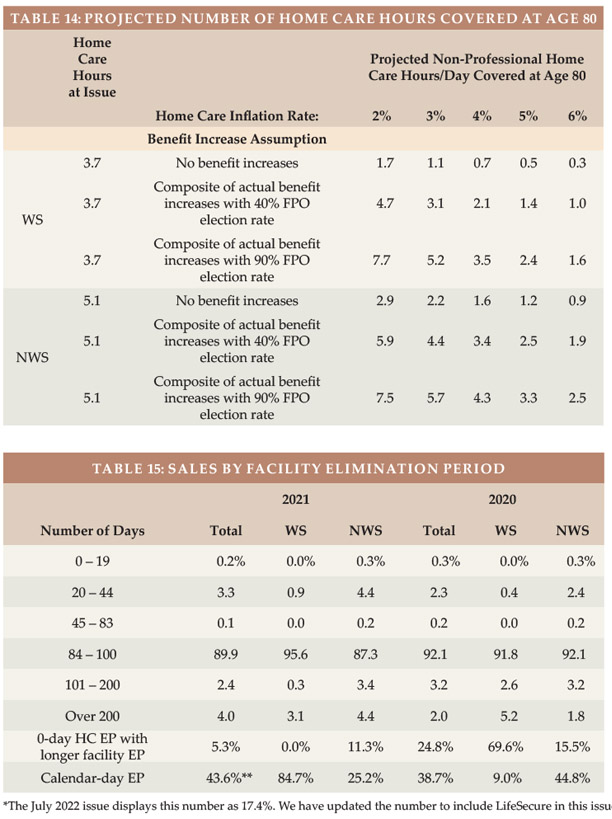
Partnership Program Background
When someone applies to Medicaid for long-term care services, most states with Partnership programs disregard assets up to the amount of benefits received from a Partnership-qualified policy (some IN and NY policies disregard all assets). Partnership programs exist in 44 jurisdictions (all but AK, DC, HI, MA, MS, UT, and VT), but MA has a similar program (MassHealth). The first four states to develop Partnerships (CA, CT, IN and NY) have different rules, some of which have become a hindrance to sales. We are not aware of a Partnership-qualified WS LTCI product in those four states, which is unfortunate because the WS market serves many people who could benefit from Partnership.
To qualify for a state Partnership program, a policy must have a sufficiently robust benefit increase feature. Many jurisdictions have lowered the minimum Partnership-eligible compounding benefit inflation rate to one percent. To facilitate Partnership sales in such jurisdictions, an insurer could lower its minimum size by 1/3 (e.g., from $1,500 to $1,000) if one percent compounding is included in a core program. The revenue from the core program would typically increase. The premium would be more level by issue age, shifting risk to the younger ages which can be preferable for the insurer in a core program.
Jurisdictional Distribution
Click here for a chart of the market share of each US jurisdiction relative to the total, WS and NWS markets, and the Partnership percentage by state. This chart indicates where relative opportunity may exist to grow LTCI sales.
Elimination Period
Approximately 90 percent of the NWS market buys 90-day elimination periods (EPs). For that reason, many WS programs offer only a 90-day EP.
Table 15 shows distribution by EP and how many policies had a 0-day home care feature and a longer facility EP and how many policies had a calendar-day EP (as opposed to a service-day EP). We have reflected that all LifeSecure policies are 90-day EP with a calendar-day definition. Policies which have 0-day home care EP and define their EP as a service-day EP operate almost identically to a calendar-day EP, because people in facilities get daily care.
The large drop in WS 0-day home care EP reflects that Transamerica was in our data last year, but not this year.
Gender Distribution and Sales to Couples and Relatives
Insurers began gender-distinct LTCI pricing in 2013, but as explained above, unisex pricing continues in the WS market.
In the NWS market, the 2013-2015 percentages of females were high as insurers that still offered unisex pricing attracted single females. The next 5 years, the percentage of female buyers in the NWS was stable, fluctuating from 54.3 to 54.9 percent. In 2020, women constituted 50.8 percent of the US age 20-79 population2, but in 2021 the percentage of females in the NWS market dipped below 50 percent (49 percent) because of the higher number of males purchasing coverage in WA.
In the WS market, the high percentage of female WS buyers from 2015-2018 suggests that women were particularly attracted to WS LTCI (presumably because of unisex pricing). To the degree that our more recent WS data is over-weighted to executive carve-out programs, it reflects less of the gender anti-selection that likely still exists. Although most executives are male, executive ranks are becoming more gender-balanced and many executive carve-out programs cover spouses. Women make up 47 percent of workers3 but accounted for a bit less (46 percent) of our reported 2021 WS sales. For the third straight year, our data (overly weighted toward executive carveout) has indicated negative gender anti-selection in the WS market, as the 2021 shift to males was stronger in our WS data than in our NWS data.
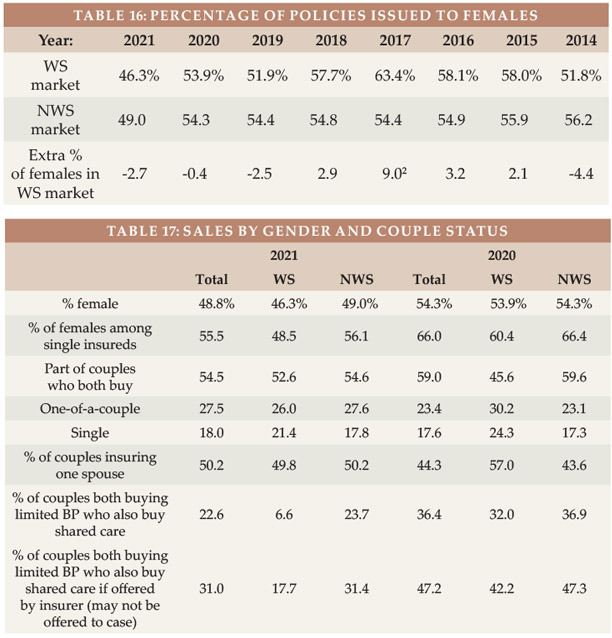
Table 17 digs deeper, exploring the differences between the WS and NWS markets in single female, couples and Shared Care sales.
Our WS data had fewer single buyers. Despite having more married buyers, there were fewer one-of-a-couple sales and “both buy” couples increased from 45.6 percent of sales to 52.6 percent.
In contrast, the percentage of single people and one-of-a-couple both increased in the NWS market.
Shared Care sales dropped but are likely to rebound in 2021.
Our limited data with regard to relatives who buy shows that two spouses are insured for every three employees. That’s a high percentage reflective of executive carve-out data. Only about one percent of purchasers are relatives other than the employees and employees’ spouses.
Type of Home Care Coverage
Table 18 summarizes sales by type of home care coverage. Historically, the WS market sold few policies with a home care maximum equal to the facility maximum. However, with increasing emphasis on home care and simplicity, that difference faded.
Table 18 also shows that monthly determination dominates both markets. The low 2020 monthly determination percentage in the WS was caused primarily by a change in distribution of WS sales among participants.
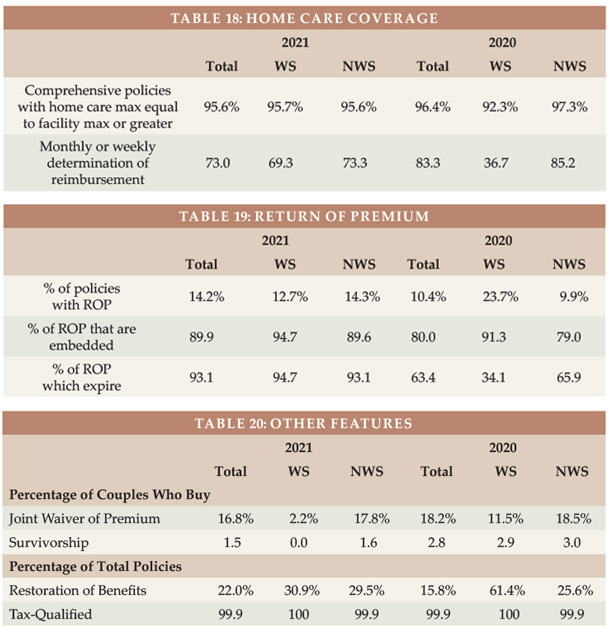
Many WS products embed a “partial cash alternative” feature (which allow claimants, in lieu of any other benefit that month, to use approximately 1/3 of their benefit for whatever purpose they wish, with the balance extending the benefit period) or a small informal care benefit.
Other Features
Table 19 shows that almost all Return of Premium (ROP) features were embedded (automatically included) and phased out before death would be likely. ROP with expiring death benefits may provide an inexpensive way to encourage more young people to buy LTCI but does not address the buyer’s concern (what if I keep paying all my life, then die without qualifying for benefits?).
Table 20 shows lower Joint Waiver of Premium and Survivorship sales to couples in the WS market than in the NWS market, mostly due to differences in distribution by carrier. Some products automatically provide Joint Waiver of Premium if a couple buys identical coverage or if a couple buys Shared Care. Employers sometimes are disinclined to add an optional couples’ feature because they are already contributing more money to cover a married employee plus that employee’s spouse than the cost for a single employee the same age.
CLOSING
We thank insurance company staff for submitting the data and responding to questions promptly. We also thank Sophia Fosdick, Rachelle Jacobs, and Zane Truesdell of Milliman for managing the data expertly.
We reviewed data for reasonableness. Nonetheless, we cannot assure that all data is accurate.
If you have suggestions for improving this survey, please contact one of the authors.
References
- Elizabeth Hovde, “Update on number of people opting out of state’s long-term-care program”, June 15, 2022, http://www.washingtonpolicy.org/publications/detail/update-on-number-of-people-opting-out-of-states-long-term-care-program#:~:text=People%20who%20have%20private%20long,apply%20for%20exemption%20until%20December.
- https://www.statista.com/statistics/241488/population-of-the-us-by-sex-and-age/.
- Bureau of Labor Statistics, https://www.bls.gov/cps/cpsaat11.htm.




























